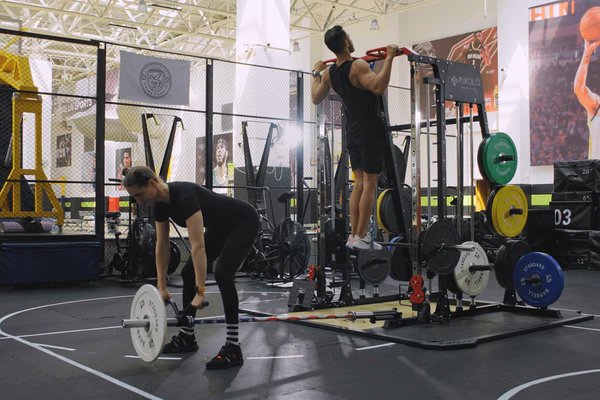The Smith Machine: A Comprehensive Guide for Workout

In the realm of fitness equipment, the Smith Machine stands out as a multifunctional powerhouse, essential for anyone serious about strength training. This article offers an in-depth exploration of the Smith Machine, discussing its benefits, versatility in exercises, and how to integrate it into your workout regimen for optimal results. Go with home gym Smith machine
What is a Smith Machine?
The Smith Machine is a type of gym equipment that features a barbell fixed within steel rails, allowing for only vertical or near-vertical movements. This setup provides a controlled environment for lifting, reducing the risk of injury and helping users to maintain correct form throughout their exercises.
History and Mechanism of the Smith Machine
Invented by Jack LaLanne and later popularized by Rudy Smith in the mid-20th century, the Smith Machine was designed to offer a safer, more controlled method of weight training. The machine typically includes a series of slots on the frame where the barbell hooks can be locked in place, allowing for a stop at any point during an exercise. This feature is particularly useful for those lifting heavy weights or working out without a spotter.
Benefits of Using the Smith Machine
Safety
The Smith Machine’s controlled path of motion reduces the risk of common lifting injuries related to balance and incorrect form. It is particularly beneficial for beginners or those recovering from injuries, as it allows the lifter to focus on form and technique without the unpredictability of free weights.
Versatility
Contrary to some misconceptions, the Smith Machine is not just for squats and bench presses. It can be used for a wide array of exercises, including overhead presses, deadlifts, rows, and more, making it a versatile addition to any workout plan.
Isolation of Muscle Groups
The fixed pathway of the barbell helps in isolating specific muscle groups more effectively than free weights, allowing for targeted strength gains and muscle growth.
Suitability for All Fitness Levels
Whether you’re a novice learning the basics of weight training or an experienced athlete focusing on specific muscle gains, the Smith Machine can be adjusted to suit various fitness levels and goals.
Essential Exercises to Perform on a Smith Machine
Squats
Using the Smith Machine for squats helps maintain an upright posture, reducing stress on the lower back and allowing for a deeper, safer squat.
Bench Press
The Smith Machine bench press supports the back and allows the user to focus purely on the pectoral muscles, reducing the risk of shoulder injuries and enhancing muscle engagement.
Overhead Press
Performing overhead presses on the Smith Machine stabilizes the back and prevents the unnecessary sway that can occur with free weights, focusing the effort on the deltoids.
Rows and Deadlifts
For back and leg workouts, the Smith Machine ensures that movements are smooth and controlled, which helps in maintaining proper form and preventing strain.
Smith Machine vs. Free Weights
While the Smith Machine offers numerous benefits, it’s important to balance its use with free weights, which provide the following advantages:
- Engagement of Stabilizing Muscles: Free weights require the lifter to control the path of the barbell, engaging more stabilizing muscles and promoting better overall muscle coordination.
- Natural Movement: Free weights more closely mimic natural body movements, which can be beneficial for functional strength and everyday fitness.
Tips for Incorporating the Smith Machine into Your Fitness Routine
- Start with Light Weights: Master the form of each exercise with lighter weights before progressing to heavier loads.
- Combine with Free Weights: Use both the Smith Machine and free weights in your routine to maximize muscle engagement and prevent over-reliance on the machine’s stability.
- Vary Your Exercises: Regularly change the exercises you perform on them to continuously challenge your body and prevent plateauing.
The weight of a barbell on a Smith machine can vary depending on the model and manufacturer, but it’s generally lighter than a standard Olympic barbell due to the machine’s design which often includes counterbalancing.
Common Weights of Smith Machine Bars
- Standard Weight: A typical Smith machines bar weighs between 15 to 25 pounds (7 to 11 kg). This is lighter than the standard Olympic barbell, which usually weighs about 45 pounds (20 kg).
- Counterbalanced Bars: Some Smith machines feature a counterbalance system that reduces the effective weight of the bar. In these systems, weights or mechanisms offset the weight of the bar, making it easier to lift. The actual weight you’re lifting can sometimes be as little as 0 to 10 pounds (0 to 4.5 kg), depending on the degree of counterbalancing.
Setting up a Smith machine in a home gym can be a great addition for those looking to enhance their strength training regimen. They offers versatility and safety, making it suitable for a wide range of exercises, including squats, bench presses, and shoulder presses. Here’s a detailed guide to consider if you’re thinking about adding a Smith machine to your home gym setup.
Read Also: https://blogrism.com/saudi-arabia-health-fitness-service-market-forecasts-8-5-cagr-growth-through-2030/
Considerations Before Purchasing a Smith Machine
- Space Requirements:
- Dimensions: Smith machines are typically larger and taller than other gym equipment. Ensure your space can accommodate its size, not just in terms of floor area but also ceiling height.
- Clearance: Consider extra space for safe operation around the machine, including room for adjusting weights and moving comfortably during exercises.
- Weight Capacity:
- User and Weight Load: Check the maximum weight capacity of the machine, while which should include the user’s weight and any additional weight plates.
- Features and Accessories:
- Counterbalancing: Some home gym Smith machines have counterbalanced bars to reduce the effective weight of the bar, making it easier to lift.
- Attachments: Look for models that include or are compatible with other attachments like cable pulleys, pull-up bars, dip stations, and adjustable benches to expand exercise options.
- Safety Mechanisms: Safety is crucial, especially when lifting alone. Smith machines with reliable safeties can catch the bar at any point during a lift.
Factors Influencing Bar Weight
- Design: The construction of the Smith machine, including the presence of counterbalances and the type of bearings or guide rods used, can significantly impact the bar’s weight.
- Manufacturer: Different brands might use different materials and designs, leading to variations in bar weight.
Checking Bar Weight
To determine the exact weight of the bar on a specific Smith machines, consider these methods:
- Manufacturer’s Specifications: Check the user manual or manufacturer’s website for specifications. This is often the most accurate source of information.
- Onsite Verification: If you’re at a gym, you can ask a staff member, or you can use a scale to measure the bar’s weight directly if one is available.
- Trial and Error: By comparing how lifting the machine bar feels relative to known weights on free-weight barbells, you can estimate its weight.
Understanding the weight of the Smith machine bar is important for accurately tracking your lifting progress and ensuring consistency in your workout intensity.
Read also: https://blogrism.com/7-must-have-fitness-gear-and-equipment-for-an-effective-home-gym/
Conclusion
The Smith Machine is a powerful tool in the arsenal of gym equipment, providing a safe, versatile, and effective way to enhance your strength training routine. Whether used as part of a mixed equipment workout or as a standalone solution, they can help you achieve your fitness goals with an added layer of safety and efficiency. By understanding and utilizing the capabilities of them, you can maximize your workout potential and see significant improvements in your fitness journey.




